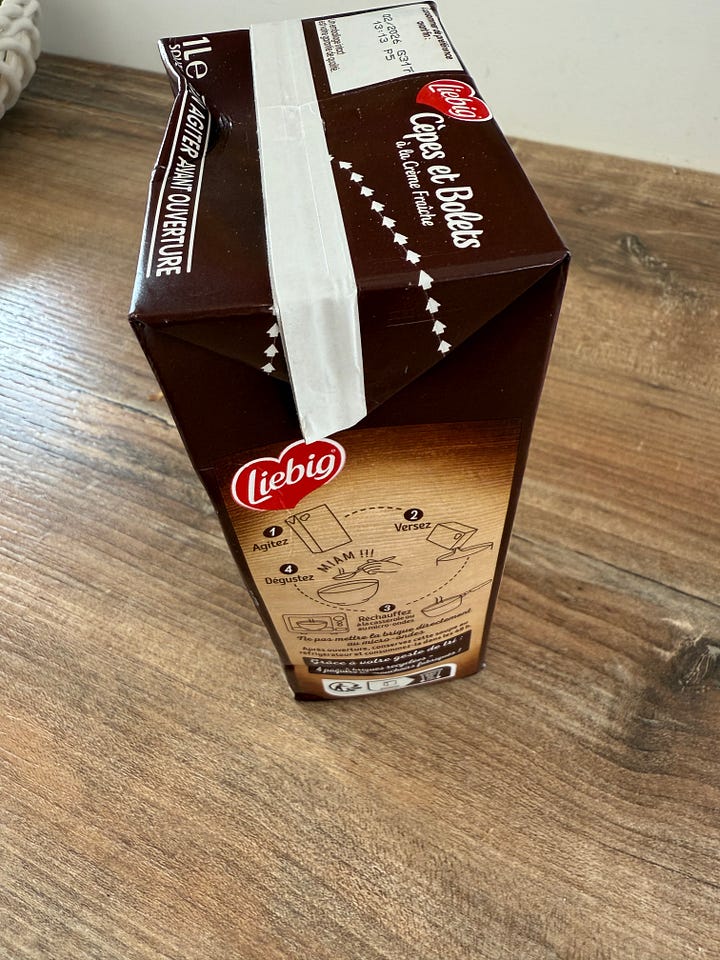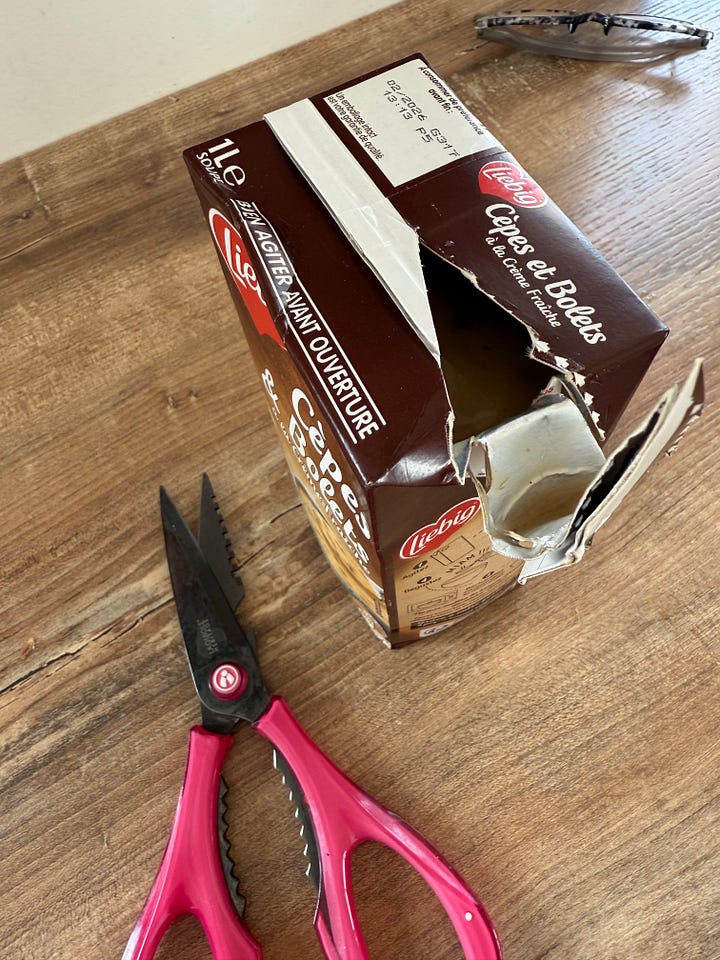There is so much incredible stuff here in France. I wish I could open it all.
Instead, I spend an annoying part of each day trying to pry open various packages, containers and bottles. Food, medication, beverages, toiletries. I’m always either struggling to figure out how to get in there, or repairing the damage I cause from getting in there the wrong way.
Of course the US has its own packaging issues. Have you ever tried to get at a new toothbrush embedded in one of those impregnable clamshell packages? Or open a child-proof pill bottle? It’s just that French packaging is so different from what I’m used to – like their door knobs and light switches and money and weights and measures and rules of social interaction. Most of the variations are the product of the European Union’s environmental consciousness. In the US, for example, soup usually comes in a can or a cardboard box with a little plastic spout. My favorite soup here also comes in a cardboard box, but that little plastic doohickey is frowned upon.
One of the most surprising containers I have encountered holds the monthly dose of Vitamin D our doctor prescribes to help us survive Brittany’s gray, cloudy winters. I expected a tablet, maybe a capsule, certainly not a glass vial of liquid. This took a good bit of YouTubing and a little bit of courage before I could safely ingest it. (Hint: You break one end off, hold that over a juice glass – or tongue, if you dare – then break the other end to start it flowing. Have Band-Aids at the ready.)
Other medications are no picnic, either. All pills and capsules here come in blister packs. This type of packaging protects the meds from humid environments, provides child safety, enhances dispensing accuracy and allows for quicker visits at the pharmacy. Here, there is no, “come back in 30 minutes” to pick up your antibiotics because we have to count them out like poor Mr. Gower. Some have even suggested that blister packs may cut down on the rate of suicide. The downside of this packaging is that you have to push each one of those buggers out of its little cell . . . every morning. Sometimes this works and sometimes my tiny cholesterol pill pops right down the bathroom sink drain.
These incidents are disheartening but the container that repeatedly breaks my brain and spirit is for the aforementioned soup. It is an environmental marvel: Not one bit of plastic on this cardboard box. It comes with instructions on how to cut the top along the dotted line to create a spout. I have never once been able to accomplish this. I eventually end up Edward Scissorhands-ing the damn thing and cleaning the massive spill after lunch. (Do not even suggest that I buy another kind of soup in a less cranky container. This particular mushroom soup is delicious and not salty like every pre-made soup I’ve had in the US.)


This is not to say that all packaging – or lack thereof – is annoying. In fact, there are some wonderful ideas here.
You can buy eggs in quantities of 4, 6, 10, 12 and 18. Or, bring your own container to the supermarket and take what you want from a tray of dozens. Only need two branches of celery for that recipe? Go ahead and snap them off of the bunch in the produce aisle. Want only one can of coke from the six pack on the shelf? Open the pack and take just one.
But when the people at the French equivalent of Reynolds Wrap sat down to design their box, they lost their way. Using kitchen wrap is a daily game of rock, paper, scissors. I consistently ravage the box because the zigzag of teeth along the cutting edge is made of nothing more than thin cardboard and it just doesn't cut it. Literally. The flaccid edge is not strong or stable enough to pierce tin foil or plastic wrap. It just bends, forcing me to rip freestyle, like some kind of animal.

I got all excited once when I found a box of cling wrap that advertised how easy it was to cut. When I got it home I realized the ease came courtesy of not having any cutting edge at all, compelling you to take the roll out of the box and tear it by hand. It didn’t seem that easy to me. Maybe I should have started the slice with my teeth or something. What I need is what the geniuses at Reynolds Wrap provide: a sharp and dangerous metal cutting edge.
There’s been a good bit of confusion expressed on social media lately about the new packaging for disposable bottles in Europe. In its enthusiastic environmentalism, the European Union last year introduced a bottle cap designed to reduce the number of loose plastic caps that don’t make it into the recycling stream once they are separated from their bottles. The new caps are tethered to bottles of soda, juice, water and milk by a remarkably strong plastic strip.
There’s actually a fancy way of slipping the tether over the mouth of the bottle to get it out of the way, but that’s way too much trouble to do every time you want a sip. Nonetheless, I stand firmly behind this effort to reduce plastic trash – right up until the moment the sharp, ragged edge of the dangling cap edge slices my nose as I take a swig of sparkling water.
If only I could figure out how to use that ragged cap to cut aluminum foil.







When I last came back to France from the US, I had 6 rolls of Press N Seal in my suitcase. And I will not apologize.
Oh, this is excellent!
Recently I saw someone write something just about those liquid medicine containers and coincidentally, my (French) husband had just cut himself with one, rather badly actually.
As for foil and plastic wrap, I realize that after years of frustration, I've basically learned to live without them!